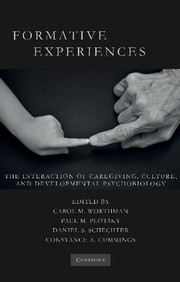Book contents
- Frontmatter
- Contents
- List of Figures
- List of Tables
- List of Contributors
- Foreword by Robert Sapolsky
- Preface
- List of Abbreviations
- Introduction
- SECTION ONE HISTORICAL, CROSS-CULTURAL, AND DEVELOPMENTAL SCIENCE PERSPECTIVES
- SECTION TWO HOW EXPERIENCE INTERACTS WITH BIOLOGICAL DEVELOPMENT
- 3 The Social Environment and the Epigenome
- 4 Sensitive Periods in the Behavioral Development of Mammals
- 5 Confluence of Individual and Caregiver Influences on Socioemotional Development in Typical and Atypical Populations
- 6 We Are Social – Therefore We Are: The Interplay of Mind, Culture, and Genetics in Williams Syndrome
- SECTION THREE FORMATIVE RELATIONSHIPS WITHIN AND ACROSS GENERATIONS
- SECTION FOUR SOCIAL AND CULTURAL CONTEXTS OF CHILDHOOD DEVELOPMENT – NORMATIVE SETTINGS, PRACTICES, AND CONSEQUENCES
- SECTION FIVE FEAR, FUN, AND THE BOUNDARIES OF SOCIAL EXPERIENCE
- SECTION SIX PUBLIC HEALTH, EDUCATION, AND POLICY IMPLICATIONS
- Index
- References
5 - Confluence of Individual and Caregiver Influences on Socioemotional Development in Typical and Atypical Populations
Published online by Cambridge University Press: 26 May 2010
- Frontmatter
- Contents
- List of Figures
- List of Tables
- List of Contributors
- Foreword by Robert Sapolsky
- Preface
- List of Abbreviations
- Introduction
- SECTION ONE HISTORICAL, CROSS-CULTURAL, AND DEVELOPMENTAL SCIENCE PERSPECTIVES
- SECTION TWO HOW EXPERIENCE INTERACTS WITH BIOLOGICAL DEVELOPMENT
- 3 The Social Environment and the Epigenome
- 4 Sensitive Periods in the Behavioral Development of Mammals
- 5 Confluence of Individual and Caregiver Influences on Socioemotional Development in Typical and Atypical Populations
- 6 We Are Social – Therefore We Are: The Interplay of Mind, Culture, and Genetics in Williams Syndrome
- SECTION THREE FORMATIVE RELATIONSHIPS WITHIN AND ACROSS GENERATIONS
- SECTION FOUR SOCIAL AND CULTURAL CONTEXTS OF CHILDHOOD DEVELOPMENT – NORMATIVE SETTINGS, PRACTICES, AND CONSEQUENCES
- SECTION FIVE FEAR, FUN, AND THE BOUNDARIES OF SOCIAL EXPERIENCE
- SECTION SIX PUBLIC HEALTH, EDUCATION, AND POLICY IMPLICATIONS
- Index
- References
Summary
INTRODUCTION
Children exhibit a range of individual differences in reactions to the world at birth. Some are easily soothed, develop regular sleep-wake cycles, react positively with approach behaviors toward novel stimuli, and easily adapt to environmental changes. Other infants display high rates of negative emotions, are difficult to soothe, become easily overwhelmed by novel stimuli, react negatively to environmental changes, and have irregular sleep-wake patterns. These early individual differences make up what we call temperament. The interaction of temperament and environmental influences presumably shapes socioemotional development.
In this chapter, we illustrate how individual and caregiver differences influence socioemotional development in typical and atypical populations. The chapter comprises two major sections. The first section sets forth an overview of three models of development that can inform socioemotional development: temperament, attachment, and interactionist approaches. For each model, we give a brief historical overview and discuss definitional, conceptual, and cross-cultural issues. Section two presents how these models may shed light on socioemotional development in typical and atypical populations, using childhood shyness and childhood maltreatment and autism, respectively, as examples. We conclude with suggestions for future work examining individual and caregiver influences on socioemotional development.
MODELS OF DEVELOPMENT
Temperament Theories
Historical Precedent and Definitional Issues. The first western scientific theory of temperament was proposed in the 2nd century A.D. by Galen, a Greek physician. Galen's theory suggested that individual temperament differences could be explained by the balance between four bodily humors or fluids: flegma, chole, melanchole, and sanguis (Galen, 170 A.D.).
- Type
- Chapter
- Information
- Formative ExperiencesThe Interaction of Caregiving, Culture, and Developmental Psychobiology, pp. 106 - 135Publisher: Cambridge University PressPrint publication year: 2010



